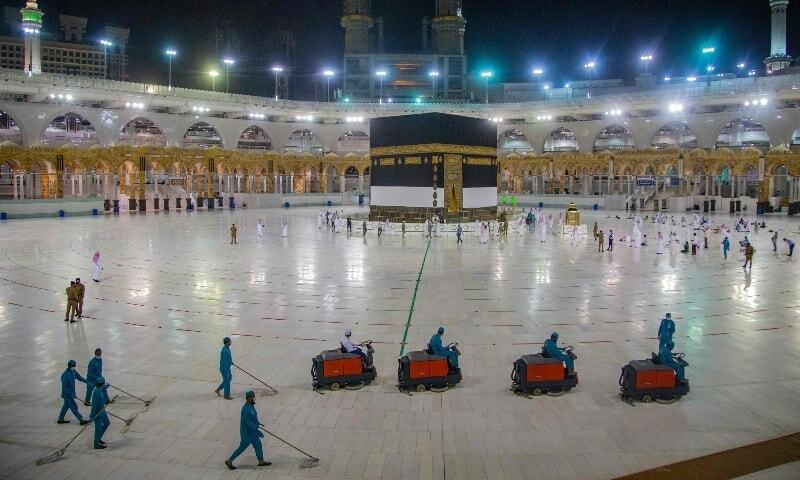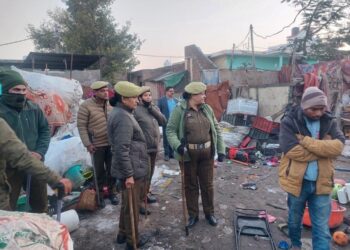
Riyadh- The vast white marble floors surrounding Islam’s holiest site, the Holy Kaaba in Makkah, would normally be packed with hundreds of thousands of pilgrims from around the world the day before the Haj.
On Tuesday, however, only a few officials and workers putting last minute preparations in place were seen at the Grand Mosque housing the Kaaba.
In place of the 2.5 million pilgrims who preformed the Haj last year, only a very limited number of faithful anywhere from 1,000 to 10,000 are being allowed to take part in what is largely a symbolic pilgrimage amid the coronavirus outbreak.
The select few approved for this year’s Haj have been tested for the virus and are self-isolating in hotel rooms in Makkah, where they will experience an ancient pilgrimage, albeit tailored this year for a modern-day global pandemic.
Amr Al-Maddah, the chief planning officer at the Ministry of Haj, is helping incorporate the latest technology into the pilgrimage such as thermal scanners and electronic ID cards.
“Right now, technology is our black horse to developing the whole Haj journey,” said Al-Maddah, an electronics engineer with a PhD in robotics and artificial intelligence.
“We are taking every step possible to make sure that this Haj will end with zero cases of Covid-19 and also with zero deaths in our total Haj numbers,” he told The Associated Press.
Before pilgrims could even enter Makkah, they were given wristbands by the Saudi health ministry to monitor their movements and ensure the mandatory quarantine was observed. Thermal scanners are being used across the holy site to monitor people’s temperatures.
Each pilgrim is assigned to a group of around 20 others. A group leader will guide them throughout the Haj to each destination at a specified time, to avoid crowding in places like the Grand Mosque, where the pilgrims circle the Kaaba and follow a path traveled by the Prophet Abraham’s wife, who Muslims believe ran between two hills searching for water for her dying son.
While on Mount Arafat, where the Prophet Muhammad (PBUH) delivered his final sermon nearly 1,400 years ago and where pilgrims will spend Thursday in deep prayer and repentance, pilgrims will be wearing high-tech ID cards that connect to an application on their phones.
The card and app allows the government to easily monitor the pilgrims, and gives them a way to reach out to their group leader and make special meal requests.
The card stores the pilgrims’ personal information, health status, residence and other Haj-related details. In the future, Al-Maddah said the cards will be fitted with a location tracker to follow individual pilgrims’ movements. The tracker will be managed by a control room, and can be used as a pay card in place of cash.
Pilgrims have also been given special attire to wear during the Haj laced with silver nano technology that helps kill bacteria and makes clothes water-resistant.
Al-Maddah said the measure is a precaution, even if it can affect almost nothing or has a minimal chance of improving health conditions.
It’s all part of the special treatment pilgrims are receiving this year. Other perks such as meals, hotel accommodation, transportation and healthcare is paid for by the Saudi government. Typically, the Haj can cost thousands of dollars for pilgrims who save for a lifetime for the journey.
This year marks the first time in nearly a century of Saudi rule over Makkah that people from outside the kingdom will not take part in the five-day Haj, which is a once in a lifetime requirement of Muslims.
Al-Maddah, who sits on the Haj planning committee, said allowing people to enter Saudi Arabia from abroad would have posed a global health risk.
Two thirds of pilgrims this year are foreigners already residing in Saudi Arabia from among the 160 different nationalities that would have normally been represented at the Haj. The other one third are Saudi security personnel and medical staff.
All pilgrims had to be between the ages of 20 and 50 with no terminal illnesses and showing no symptoms of the coronavirus.
Each year, the Haj poses a massive logistical challenge for Saudi authorities. As recently as 2015, a stampede killed more than 2,400 people.
Crowd control measures require the use of thousands of cameras and security officers to coordinate the movements of the more than 2.5 million people densely packed into narrow streets, walkways and paths.
Facial recognition technology and other high-tech security systems have to be advanced enough to decipher between pilgrims, dressed in nearly identical terry white cloth garments.
“For us, safety comes first,” Al-Maddah said. “We are employing technology to make sure that these services and these precautions are met and delivered in the highest standard.”
Follow this link to join our WhatsApp group: Join Now
Be Part of Quality Journalism |
Quality journalism takes a lot of time, money and hard work to produce and despite all the hardships we still do it. Our reporters and editors are working overtime in Kashmir and beyond to cover what you care about, break big stories, and expose injustices that can change lives. Today more people are reading Kashmir Observer than ever, but only a handful are paying while advertising revenues are falling fast. |
| ACT NOW |
| MONTHLY | Rs 100 | |
| YEARLY | Rs 1000 | |
| LIFETIME | Rs 10000 | |










